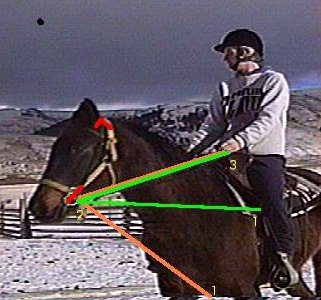Medicine Lodge Valley, Dillon, Montana
Drawreins
![]()
We know what the drawreins do in appearance but do people know what the feeling of draw reins is to a horse.

With drawreins they look like the green or the orange lines in the photo.
-
What do the green and orange lines look like?
~ A pulley. -
What is the function of a pulley?
~ It brings an object away from where it is to a point in which it is in the middle of two points of pulling with greater force. -
The parts in the photo are numbered 1, 2 , and 3.
~ 1 is one end that is tied to a solid object - cinch/girth or the saddle ring
~ 2 is the pulley block - the bit ring.
~ 3 is the end that is equal to one power by itself - the riders hands. -
By attaching 3 and go through 2,
~ 1 has twice the power to influence the object attached to 3.
~ It changes the direction of the object and the force on the number 3 end.Now how the object moves to this is what the stickler is.

-
(Use in conjunction with the first photo) If you had a broken log and you attached the pulley(2) on to the front of the log and tied the solid end to a stationary object (1) and used a pulling back force (3) we'll say a tractor that could not pull the log if hooked with a single straight line or had great ease using the pulley system.
-
The broken log symbolizes the jaw or the poll.
-
4 is the bit ring
-
5 is the mouth/poll
-
6 is the rest of the body.
-
In A there is no forced tension yet.
-
In B the pulley pulls on the attached object as the object gets pulled the broken log receives tense where it is broke.
~ The broken section cannot follow the front half, because the pulley could not help the back half of the broken log.
~ In C the front half of the log (4) is where it needs to be but the broken half (6) is still in the same location as in A as nothing helped it along.
~ The space in-between (5) is separated at a great distance.
Try the drawrein action on yourself.
-
One person being the horse and the other is the rider.
-
Use one long string as the reins and run through your mouth acting as the bit.
-
What happens with your head?
~ Feel the tension on the jaw and top of the neck. -
What does the rest of the body feel like?
~ Tension in the shoulders.
~ Nothing is a developed rising. But all a put in to a placed position. -
Now relaxed round yourself.
~ There is no tension with the jaw.
~ The neck muscles and vertebra are rounding comfortably.
~ No tension in the shoulder.
~ There is stretching all around
![]()
|
|
||||||
|
|
|
© Donna
Hildreth 1998 - 2009
DbarH Logo designed by Horsedesigns.
